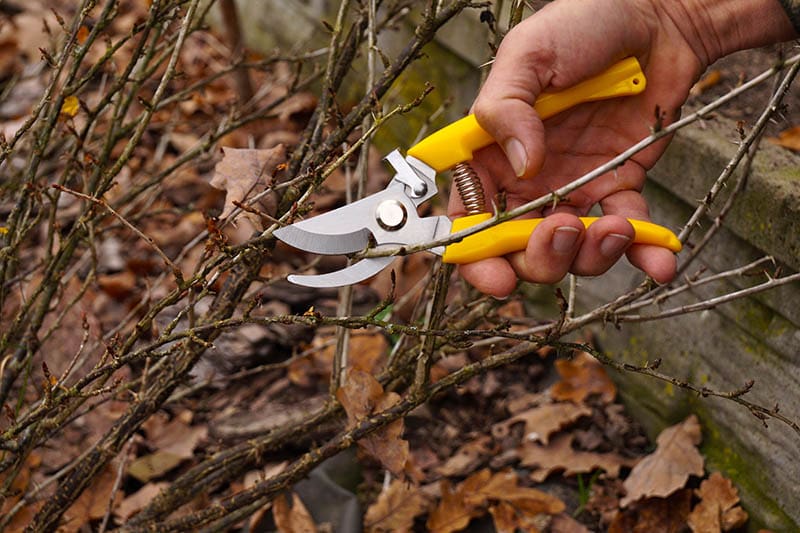When & How to Prune Dogwood Trees: 5 Expert Tips
-
Kristin Hitchcock
- Last updated:

If you want your landscaping to look nice and put together, you’ll usually need to trim just about every plant. Otherwise, one plant may become overgrown. While this does make your garden look a bit less kept, overgrown plants can also choke out less-successful plants. They may also overgrow their resources and the space around them.
In the wild, plants would usually be eaten back by various animals. In our gardens, where other animals are not present, we have to replicate this. Dogwood trees need to be trimmed like anything else—usually, at least. These trees don’t grow as prolifically as others, so you may be able to skip trimming your dogwood if you give it enough space to grow.
If you decide to trim your tree, there is a right way to do it. Trimming your tree incorrectly or at the wrong time can lead to damaging the tree.
When to Prune
You should prune your dogwood tree during the winter. During this time, the tree should be dormant. This means it shouldn’t be growing any flowers or berries and you shouldn’t affect the tree’s blooms for the following spring by trimming in the winter.
Furthermore, insects are more active when it is warmer. Therefore, they may be more likely to take advantage of the cuts if you trim your tree when they are around. To protect your tree, only prune when insects are not active.
The 5 Tips on How to Prune Dogwood Trees
1. Remove Any Dead Limbs
Trees naturally have spots that will die off. Often, these may have been purposefully killed by the tree if the branches weren’t serving it anymore. However, diseases and pests can also kill parts of the tree. Remove these annually when you prune your tree.
Dead wood can become moldy and attract insects. Therefore, leaving it can actively damage the tree. You should preferably remove any dead wood as you notice it. However, pruning is a great time for a close inspection to ensure that you remove all dead limbs.
While you’re at it, you should also remove any dying branches. Diseased limbs and those covered with insects aren’t doing much for the tree. They may infect your tree if left on so they should be removed quickly. Sterilize your shears or saw after removing these branches to ensure the disease doesn’t spread.

2. Prune Twiggy Stems
In some dogwood varieties, the tree may produce twiggy stems that are unsightly and don’t have many leaves. These can be trimmed back to provide room for healthier growth. Often, the tree will purge these branches eventually, anyway. Plus, this also encourages growth.
While bush dogwood can be trimmed down to the ground every few years, you should be cautious regarding trimming trees. Trees don’t bounce back as fast after trimming, so be cautious when removing stems.
3. Thin Crowded Areas
Crowded areas can promote disease and insects. Therefore, if a part of the tree looks unusually crowded, remove the weaker branches in that area. Again, the tree will purge most weak branches naturally as it grows, especially when the branches no longer get sunlight. However, you can give a helping hand by cutting these back to their point of origin.
You probably won’t have to do this every year, though.

4. Consider Removing Lower Branches
Sometimes, as a dogwood tree grows, the lower branches may remain a bit too low to the ground. These may be low enough to interfere with walking, or they can even get in the way of the tree receiving adequate circulation. Branches touching the ground can be more prone to insects and disease.
Therefore, every few years, you should look at the lower branches and consider if they should be removed. Often, these lower branches will need to be sawed off, as they can be very thick.
5. Snip Away Some Flower Buds
In some cases, you may want to snip away flower buds. Flower buds require a lot of energy to grow. If you snip some off, you can encourage the tree to grow bigger instead—if you want your tree to focus on getting big, clipping off flower buds can be helpful.
Furthermore, some dogwood varieties may produce many buds whenever you remove one. So, in these cases, removing the buds can help produce more flowers.
This type of pruning is best done in June with most dogwood trees. However, exactly when your tree flowers can help you determine the best time. You want to do it shortly before it flowers but with enough time for the tree to grow new flowers (if producing more flowers is your aim).

Conclusion
Dogwood trees are tough, so they can handle pruning better than most shrubs. However, the type of dogwood tree does matter to some extent. So, you should consider the type of tree you have when following some of the advice above.
Still, the general points are all the same. You want to trim your tree during the winter when bugs aren’t around. Dead and infected branches should be removed ASAP, as they can cause problems for the rest of the tree. Trimming flower buds can sometimes be useful. However, it depends on what you’re trying to achieve and the type of tree.
Related Reads:
- 4 Tips on When and How to Prune Burning Bush – You Need to Know!
- 10 Tips on When and How to Prune Oak Trees (With Pictures)
Featured Image Credit: Dariush M, Shutterstock
Contents

